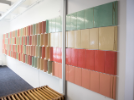Terra cotta twist on the mundane faculty mailbox

New faculty and staff mailboxes made out of terra cotta clay blocks were installed recently in Hayes Hall. It was the winning design in an in-house competition. Photo: Meredith Forrest Kulwicki
By David J. Hill
Published October 9, 2017 This content is archived.
Faculty mailboxes typically don’t generate much excitement. But when they’re in a building that’s on the National Register of Historic Places, and that’s home to an architecture school that has a reputation for “making,” only the best, designed in-house, will do.
Take, for instance, the faculty mailboxes in Hayes Hall, the recently renovated home of the School of Architecture and Planning. These are not your typical receptacles made of metal shelving. They are a glazed grid of etched terra cotta designed by two Department of Architecture faculty members and a recent graduate.
Last fall saw the completion of a meticulous, multi-year restoration project intended to recapture and re-energize Hayes Hall’s architectural history — it was built as an insane asylum in the late 1800s — while creating innovative spaces befitting a 21st-century architecture and planning school. For the school, it was important that no detail went overlooked, including the seemingly mundane faculty mailbox.
With the reopening of Hayes Hall, school leadership has commissioned a series of design-build competitions that will take place over the next few years, and that encourage faculty-student teams to collaborate with some of the school’s key industry partners on projects to further beautify the building. World-renowned Boston Valley Terra Cotta partnered on the faculty mailbox project, in which 14 teams — totaling 19 faculty members and 18 students — participated.
“This competition series provides a space to reflect upon our deep traditions in research through making,” says Dean Robert G. Shibley. “The mailbox competition, with the visionary partnership of Boston Valley Terra Cotta, is an emphatic opening statement of what’s possible when you combine teaching with practice.”
The winning design, titled “Bibelot” — the French word for a small decorative object or trinket — was installed the week before classes began in late August. It was created by Gregory Delaney, clinical assistant professor of architecture; Erkin Özay, assistant professor of architecture; and Nicholas Traverse, a 2016 master of architecture graduate.
Their installation features 120 individual blocks fashioned from terra cotta clay, each weighing 22 pounds. The blocks come in four different colors — peach, gold, green and pink. “Getting the glaze just how we wanted it took some trial and error. Terra cotta is an interesting material, not only in its finished state but in its workability and process,” says Traverse, who now works as an architectural designer and drafter at CJS Architects in Buffalo.
The blocks were fabricated at Boston Valley Terra Cotta in Boston, New York, which donated its time and materials. The company has collaborated with UB architecture faculty and students on numerous projects, and also made each of the 28,000 terra cotta panels that form the façade of UB’s new Jacobs School of Medicine and Biomedical Sciences building on the Buffalo Niagara Medical Campus.
Each block in “Bibelot” is L-shaped, its long side set at an angle to better perform as a masonry block. “We were thinking of the history of terra cotta as masonry block in construction,” Delaney says. “By nature of their geometry, each block locks with its neighbor to produce a system that doesn’t require any mortar or hardware screws between the units and the shelves.”
What’s more, each block is inscribed with one of 42 words that once adorned panels on the uppermost floor of the Frank Lloyd Wright-designed Larkin Administration Building in Buffalo, which was demolished in 1950. In the Larkin building, the words appeared in sets of three and were intended to infuse the office and its workers with purpose, value and self-reflection. “We used the words as a departure point to create objects of curiosity that you often find sitting on a shelf, which is where the name Bibelot and inspiration also came from,” Traverse says.
On the Hayes Hall mailboxes, each word is stretched vertically to blur the line between pattern making and typography, semiotics and cacography. (In case you were wondering, faculty were randomly assigned to each word.)
“The school has a deep connection with the city. In thinking of the colors and the words, we were looking for details that could reconstruct those connections and reveal them,” Özay says.
The installation was designed to pique viewers’ curiosity from the corridor outside. Once inside the Boston Valley Terra Cotta Faculty Lounge on the first floor of Hayes, the individual words begin to materialize, inviting users to read, touch and explore the wall.
The mailbox competition provided Boston Valley Terra Cotta with a rare opportunity to work with the clay material on a smaller scale than the large building facades the company is more accustomed to, and for an interior project. “Boston Valley jumped at the chance to be involved in a project like this where the material we work with every day is required to comply with a completely different set of rules and functionality,” says John Krouse, company president.
“The exciting part about this project is that it highlights the potential of design in our everyday lives,” Delaney says. “The act of getting mail is normally a mundane routine, but when you bring design into that, it is somehow enhanced.”
Adds Özay: “It’s an event now.”
Second place in the competition was awarded to Omar Khan and Laura Garófalo, associate professors of architecture, for “Stratum,” a structural stack of slotted modular bricks inspired by the geologic formation of clay strata. It was presented to the jury as a scaled terra cotta prototype.
Third-place “Radiant,” a glowing carousel of backlit, blue-glazed terra cotta modules, was developed by students Randy Fernando, Daniel Kleeschulte, Ashwini Karve and Garrett Brown, and Miguel Guitart, visiting associate professor of architecture.







